Apple iPad mini 3 vs. Samsung Galaxy Tab S 8.4: A Comprehensive Comparison
The tablet market has long been a battleground for tech giants, with Apple and Samsung consistently at the forefront. In 2014, both companies released two of their most compelling compact tablets: the Apple iPad mini 3 and the Samsung Galaxy Tab S 8.4. Though several years have passed since their debut, these devices remain popular on the used market and continue to be referenced in discussions about tablet evolution. This article provides an in-depth comparison of the iPad mini 3 and Galaxy Tab S 8.4, examining their design, display, performance, software, battery life, cameras, and overall value.
1. Design and Build Quality
Apple iPad mini 3
Apple’s design philosophy has always centered on minimalism and premium materials. The iPad mini 3 is no exception, featuring a sleek aluminum unibody construction that feels solid and luxurious in hand. Its dimensions are 200 x 134.7 x 7.5 mm, and it weighs 331 grams (Wi-Fi version). The device is available in three colors: Silver, Space Gray, and Gold, with the latter introduced for the first time in the iPad mini line.
The front is dominated by a 7.9-inch display, with relatively thick bezels by modern standards. The iconic circular home button now incorporates Touch ID, adding a layer of security and convenience. The overall build is sturdy, with precise machining and a seamless finish that has become synonymous with Apple products.
Samsung Galaxy Tab S 8.4
Samsung’s Galaxy Tab S 8.4 takes a different approach, favoring a slimmer and lighter profile. Measuring 212.8 x 125.6 x 6.6 mm and weighing just 298 grams, the Tab S 8.4 is both thinner and lighter than the iPad mini 3. Its plastic back features a dimpled texture, reminiscent of the Galaxy S5 smartphone, which helps improve grip but does not match the premium feel of aluminum.
The device is available in Titanium Bronze and Dazzling White. The front houses an 8.4-inch display with narrower bezels, giving it a more modern look. The home button also doubles as a fingerprint scanner, though it requires a swipe rather than a touch, which some users may find less intuitive.
Design Verdict

While the iPad mini 3 offers a more premium build, the Galaxy Tab S 8.4 wins on portability due to its lighter and thinner chassis. The choice between the two often comes down to personal preference: those valuing materials and craftsmanship may lean toward Apple, while users prioritizing portability and grip might prefer Samsung.
2. Display
Apple iPad mini 3
The iPad mini 3 features a 7.9-inch Retina IPS LCD with a resolution of 2048 x 1536 pixels, resulting in a pixel density of 324 ppi. The display is bright, color-accurate, and offers excellent viewing angles. Apple’s color calibration ensures that images and videos appear natural and vibrant. The 4:3 aspect ratio is ideal for reading and web browsing, providing more vertical space compared to widescreen tablets.
Samsung Galaxy Tab S 8.4
Samsung equips the Tab S 8.4 with an 8.4-inch Super AMOLED display, boasting a resolution of 2560 x 1600 pixels (359 ppi). This results in sharper text and images compared to the iPad mini 3. The Super AMOLED technology delivers deep blacks, high contrast, and vivid colors, making it particularly suited for media consumption. The 16:10 aspect ratio is better for watching movies, though it can feel cramped when reading or browsing the web in portrait mode.
Display Verdict
The Galaxy Tab S 8.4’s display is arguably superior, thanks to its higher resolution and AMOLED technology, which offers punchier colors and better contrast. However, the iPad mini 3’s screen is no slouch, excelling in color accuracy and outdoor visibility. Choice depends on usage: media enthusiasts may prefer Samsung, while readers and productivity-focused users might lean toward Apple.
3. Performance
Apple iPad mini 3
Under the hood, the iPad mini 3 is powered by Apple’s A7 chip (with 64-bit architecture) and 1 GB of RAM. While the A7 was cutting-edge in 2013, by the time of the mini 3’s release in 2014, it was beginning to show its age, especially compared to newer devices. Nevertheless, the iPad mini 3 handles most tasks smoothly, including web browsing, media playback, and light multitasking. Gaming performance is decent, though demanding titles may exhibit occasional frame drops.
Samsung Galaxy Tab S 8.4
The Tab S 8.4 is equipped with either a Samsung Exynos 5420 Octa-core processor (1.9 GHz quad-core Cortex-A15 + 1.3 GHz quad-core Cortex-A7) or a Qualcomm Snapdragon 800 (for LTE models), paired with 3 GB of RAM. This hardware configuration provides a significant boost in multitasking capabilities and overall speed. The Tab S 8.4 handles heavy apps, multitasking, and gaming with relative ease, outperforming the iPad mini 3 in raw benchmarks.
Performance Verdict
The Galaxy Tab S 8.4 is the clear winner in terms of performance, thanks to its more powerful processor and greater RAM. The iPad mini 3, while smooth for everyday tasks, lags behind in multitasking and demanding applications.
4. Software and Ecosystem

Apple iPad mini 3
At launch, the iPad mini 3 shipped with iOS 8 and has since received several updates, though support has now ended. iOS is renowned for its simplicity, security, and vast app ecosystem, particularly for tablets. The App Store offers a wide range of optimized apps, from productivity tools to games and creative software.
Key features include:
Touch ID: Secure fingerprint authentication.
Continuity: Seamless integration with other Apple devices.
Family Sharing: Easy sharing of purchases and subscriptions.
The iPad’s software experience is smooth, consistent, and free of bloatware. However, customization options are limited compared to Android.
Samsung Galaxy Tab S 8.4
The Tab S 8.4 launched with Android 4.4.2 KitKat and Samsung’s TouchWiz interface. Over time, it received updates up to Android 6.0.1 Marshmallow, but support has since ended. Android offers greater customization, multitasking features (such as Multi Window), and widget support.
Samsung’s additions include:
Magazine UX: A Flipboard-style home screen for news and content.
SideSync: Integration with Samsung smartphones.
Ultra Power Saving Mode: Extends battery life in emergencies.
However, TouchWiz is often criticized for bloatware and occasional sluggishness. The Google Play Store offers a vast array of apps, though not all are optimized for tablets.
Software Verdict
iOS on the iPad mini 3 provides a more polished and tablet-optimized experience, especially for productivity and creativity. Android on the Tab S 8.4 is more flexible and customizable, appealing to power users and those who value multitasking.
5. Battery Life
Apple iPad mini 3
Apple claims up to 10 hours of web browsing or video playback on a single charge, thanks to its 6470 mAh battery. In real-world usage, the iPad mini 3 consistently delivers 8–10 hours of mixed use, with excellent standby time. The efficiency of iOS contributes to its longevity.
Samsung Galaxy Tab S 8.4
The Tab S 8.4 features a 4900 mAh battery, smaller than the iPad mini 3’s. Despite the higher-resolution display, the device manages 7–9 hours of mixed use, depending on brightness and usage patterns. Ultra Power Saving Mode can stretch battery life in emergencies, though at the cost of reduced functionality.
Battery Life Verdict
The iPad mini 3 has a slight edge in battery life and standby time, but both devices offer full-day usage for most users.
6. Cameras
Apple iPad mini 3
Rear Camera: 5 MP, f/2.4, autofocus, 1080p video recording
Front Camera: 1.2 MP, 720p video
The iPad mini 3’s cameras are adequate for casual photography and video calls, but they struggle in low light and lack advanced features.
Samsung Galaxy Tab S 8.4
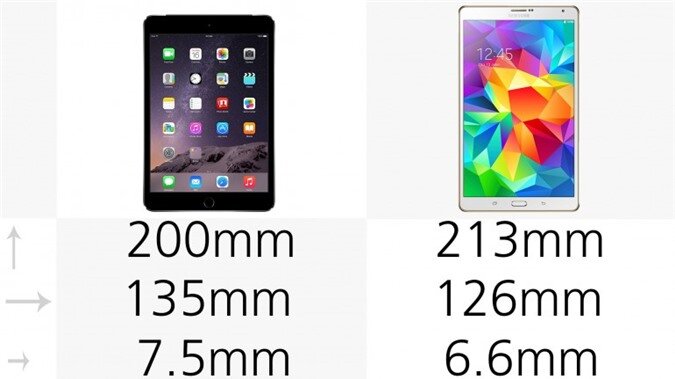
Rear Camera: 8 MP, autofocus, LED flash, 1080p video recording
Front Camera: 2.1 MP, 1080p video
The Tab S 8.4’s cameras are superior in both resolution and features, offering better low-light performance and an LED flash for the rear camera.
Camera Verdict
The Galaxy Tab S 8.4 outperforms the iPad mini 3 in camera quality and features, making it better suited for users who prioritize photography on their tablet.
7. Storage and Connectivity
Apple iPad mini 3
Available in 16, 64, and 128 GB variants, the iPad mini 3 does not support microSD expansion. Connectivity options include Wi-Fi (802.11a/b/g/n), Bluetooth 4.0, and optional LTE.
Samsung Galaxy Tab S 8.4
Offered in 16 and 32 GB versions, the Tab S 8.4 supports microSD expansion up to 128 GB, providing greater flexibility. Connectivity includes Wi-Fi (802.11 a/b/g/n/ac), Bluetooth 4.0, and optional LTE.
Storage and Connectivity Verdict
The Galaxy Tab S 8.4’s expandable storage is a major advantage for users with large media libraries or who need flexibility. Both devices offer similar wireless connectivity options.8. Audio and Speakers
Apple iPad mini 3
The iPad mini 3 features stereo speakers located at the bottom edge. Audio quality is clear and balanced, though the placement can lead to muffled sound when holding the device in landscape mode.
Samsung Galaxy Tab S 8.4
The Tab S 8.4 also has stereo speakers, but their placement on the sides provides a better stereo effect when watching videos in landscape orientation. The sound is louder and slightly richer compared to the iPad mini 3.
Audio Verdict
The Tab S 8.4 offers a superior audio experience for media consumption due to better speaker placement and output.
9. Price and Value
Apple iPad mini 3
At launch, the iPad mini 3 was priced at $399 for the base 16 GB Wi-Fi model, with higher prices for increased storage and LTE connectivity. Apple’s tablets tend to retain their value longer on the used market, thanks to brand reputation and build quality.
Samsung Galaxy Tab S 8.4
The Tab S 8.4 launched at $399 for the 16 GB Wi-Fi model, matching the iPad mini 3. However, Samsung tablets typically depreciate faster, often making them more affordable on the secondhand market.
Value Verdict
For buyers looking for long-term value retention, the iPad mini 3 is a better investment. For those seeking more features for less money, the Tab S 8.4 may be the smarter choice, especially if purchasing used.
10. Ecosystem and Accessories
Apple iPad mini 3
The iPad mini 3 benefits from Apple’s extensive ecosystem, including seamless integration with Macs, iPhones, Apple Watch, and services like iCloud, Handoff, and AirDrop. Accessory support is robust, with numerous cases, keyboards, and stands available.
Samsung Galaxy Tab S 8.4
Samsung’s ecosystem is strongest for users who already own Galaxy smartphones, smartwatches, or other Samsung devices. Integration features like SideSync and Samsung Flow enhance productivity, but the overall ecosystem is less cohesive than Apple’s.
Ecosystem Verdict
Apple’s ecosystem is more mature and integrated, providing a smoother experience for users invested in the brand.
11. User Experience and Longevity
Apple iPad mini 3
The iPad mini 3 offers a polished, reliable experience, with regular software updates (though support has now ended). Its hardware, while aging, remains capable for basic tasks, and the device is likely to remain functional for years with proper care.
Samsung Galaxy Tab S 8.4
The Tab S 8.4 provides a feature-rich, customizable experience, but suffers from slower software updates and a less optimized app ecosystem for tablets. Its hardware is more powerful, but the device may feel less smooth over time due to TouchWiz’s heavier interface.
User Experience Verdict
The iPad mini 3 excels in long-term reliability and user satisfaction, while the Tab S 8.4 offers more features and customization at the expense of occasional software hiccups.
12. Pros and Cons Summary
Apple iPad mini 3
Pros:
Premium build quality
Excellent color-accurate display
Robust app ecosystem
Seamless integration with Apple devices
Long battery life
Cons:
Aging hardware
Limited RAM
No expandable storage
Thicker bezels
Samsung Galaxy Tab S 8.4
Pros:
Superior Super AMOLED display
More RAM, better multitasking
Expandable storage
Slim and lightweight
Better cameras and speaker placement
Cons:
Plastic build feels less premium
TouchWiz can be sluggish
Faster depreciation
Less cohesive ecosystem
Both the Apple iPad mini 3 and the Samsung Galaxy Tab S 8.4 were standout tablets in their era, each catering to different user preferences.
Choose the iPad mini 3 if you value a premium build, a polished and reliable software experience, and deep integration with other Apple products. It’s ideal for users who prioritize stability, security, and a vast selection of optimized apps.
Choose the Galaxy Tab S 8.4 if you want a stunning display, superior performance, expandable storage, and more customization options. It’s perfect for media consumption, multitasking, and users who value flexibility.
In the end, both tablets reflect the strengths and philosophies of their respective brands. The iPad mini 3 is a testament to Apple’s commitment to design and user experience, while the Galaxy Tab S 8.4 showcases Samsung’s drive for cutting-edge hardware and feature-rich software.

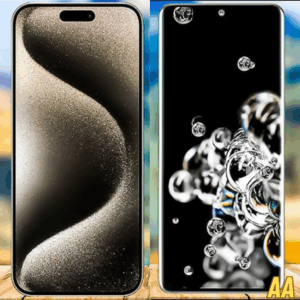

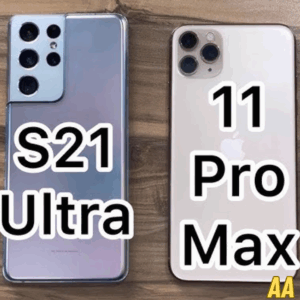
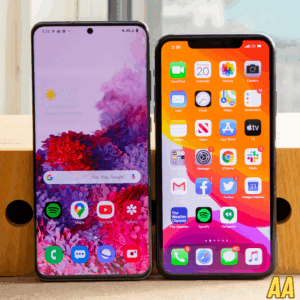
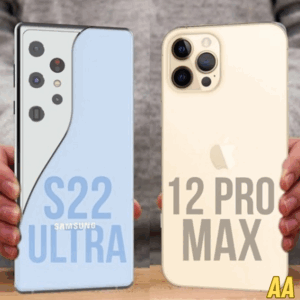


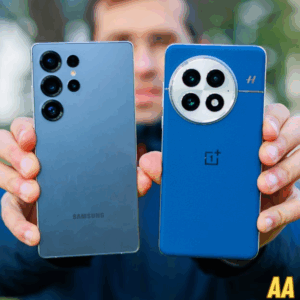
Trackbacks and Pingbacks